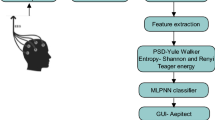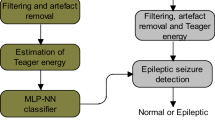Abstract
Epilepsy is a disorder of cortical excitability and still an important medical problem. The correct diagnosis of a patient’s epilepsy syndrome clarifies the choice of drug treatment and also allows an accurate assessment of prognosis in many cases. The aim of this study is to classify subgroups of primary generalized epilepsy by using Multilayer Perceptron Neural Networks (MLPNNs). This is the first study classifying primary generalized epilepsy using MLPNNs. MLPNN classified primary generalized epilepsy with the accuracy of 84.4%. This model also classified generalized tonik–klonik, absans, myoclonic and more than one type seizures epilepsy groups correctly with the accuracy of 78.5%, 80%, 50% and 91.6%, respectively. Moreover, new MLPNNs were constructed for determining significant variables affecting the classification accuracy of neural networks. The loss of consciousness in the course of seizure time variable caused the largest decrease in the classification accuracy when it was left out. These outcomes indicate that this model classified the subgroups of primary generalized epilepsy successfully.

Similar content being viewed by others

References
Pedley, T. A., Mendiratta, A., and Walczak, T. S., Seizures and epilepsy. In: Ebersole, J. S., and Pedley, T. A. (Eds.), Current practice of clinical electroencephalography. Lippincott Williams & Wilkins, USA, pp. 506–587, 2002.
Smith, S. J. M., EEG in neurological conditions other than epilepsy: When does it help, what does it add? J. Neurol. Neurosurg. Psychiatry. 76:8–12, 2005.
Smith, S. J. M., EEG in diagnosis, classification, and management of patients with epilepsy. J. Neurol. Neurosurg. Psychiatry. 76:2–7, 2005.
King, M. A., Newton, M. R., Jackson, G. D. et al, Epileptology of the first-seizure presentation: a clinical, electroencephalographic and magnetic resonance imaging study of 300 consecutive patients. Lancet. 352:1007–1011, 1998.
Trescher, H. W., and Lesser, R. P., The epilepsies. In: Bradley, G. W., and Daroff, B. R. (Eds.), Neurology in clinical practice. Buterworth-Heineman, USA, pp. 1745–1779, 2000.
Kiloh, L. G., McComas, A. J., and Osselton, J. W., Clinical electroencephalography. Butterworth, Great Britain, pp. 168–200, 1972.
Selvi, S. T., Arumugam, S., and Ganesan, L., BIONET an artificial neural network model for diagnosis of diseases. Pattern. Recogn. Lett. 21:721–740, 2001.
Tomida, S., Hanai, T., Koma, N., Suzuki, Y., Kobayashi, T., and Honda, H., Artificial neural network predictive model for allergic disease using neural network nucleotide polymorphisms data. J. Biosci. Bioeng. 93:5470–478, 2002.
Erol, R., Ogulata, S. N., Sahin, C., and Alparslan, N. Z., A Radial Basis Function Neural Network (RBNN) Approach for structural classification of thyroid diseases. The Journal of Medical Systems, (2008, in press).
Webber, W. R. S., Lesser, R. P., Richardson, R. T., and Wilson, K., An approach to seizure detection using an artificial neural network. Electroencephalogr. Clin. Neurophysiol. 98:250–272, 1996.
Pradhan, N., Sadasivan, P. K., and Arunodaya, G. R., Detection of seizure activity in EEG by artificial neural network: A preliminary study. Comput. Biomed. Res. 29:303–313, 1996.
Gabor, A. J., Seizure detection using a self-organizing neural network: Validation and comparison with other detection strategies. Electroencephalogr. Clin. Neurophysiol. 107:27–32, 1998.
Walczak, S., and Nowack, W. J., An artificial neural network to diagnosing epilepsy using lateralized burst of theta EEGs. J. Med. Syst. 25:19–20, 2001.
Subasi, A., and Ercelebi, E., Classification of EEG signals using neural network and logistic regression. Comput. Methods Programs Biomed. 78:87–99, 2005.
Alkan, A., Koklukaya, E., and Subasi, A., Automatic seizure detection in EEG using logistic regression and artificial neural network. J. Neurosci. Methods. 148:167–176, 2005.
Guler, I., and Ubeyli, E. D., Adaptive neuro-fuzzy inference system for classification of EEG signals using wavelet coefficients. J. Neurosci. Methods. 148:2113–121, 2005.
Aslan, K., Bozdemir, H., Sahin, C., Ogulata, S. N., and Erol, R., A radial basis function neural network model for classification of epilepsy using EEG signals. The Journal of Medical Systems, (2008, in press).
Sahin, C., Ogulata, S. N., Aslan, K., Bozdemir, H., and Erol R., A neural network-based classification model for partial epilepsy by EEG signals. International Journal of Pattern Recognition of Artificial Intelligence, (2008, in press).
Proposal for revised clinical and electroencephalographic classification of epileptic seizures. From the Commission on Classification and Terminology of the International League Against Epilepsy. Epilepsia. 22:489–501, 1981.
Nicolson, A., Chadwick, D. W., and Smith, D. F., A comparison of adult onset and “classical” idiopathic generalised epilepsy. J. Neurol. Neurosurg. Psychiatry. 75:72–74, 2004.
Kellaway, P., Orderly approach to visual analysis: Elements of the normal EEG and their characteristics in children and adults. In: Ebersole, J. S., and Pedley, T. A. (Eds.), Current practice of clinical electroencephalography. Lippincott Williams & Wilkins, Philadelphia, pp. 100–159, 2002.
Krose, B., and Smaget, P. V. D., An introduction to neural networks. The University of Amsterdam Press, Amsterdam, 1996.
Haykin, S., Neural networks a comprehensive foundation. Macmillan, New York, 1994.
The newsgroup for people who want to use or explore the capabilities of Artificial Neural Networks or Neural-Network-like structures. SAS Institute Inc. 2002. (Accessed on March 19, 2008 at ftp://ftp.sas.com/pub/neural/FAQ2.htm).
Duda, R. O., Hart, P. E., and Stork, D. G., Pattern classification. Wiley, New York, 2000.
Bernand, E., Optimization training neural nets. IEEE Trans. Neural Networks. 3:2989–993, 1992.
Hagan, M. T., and Menhaj, M. B., Training feedforward networks with the Marquardt algorithm. IEEE Trans. Neural Networks. 5:6989–993, 1994.
Fontenla-Romero, O., Erdogmus, D., Principe, J. C., Alonso-Betanzos, A., and Castillo, E., Accelerating the converge speed of neural networks learning methods using least squares. European Symposium on Artificial Neural Networks, 255–260, 2003.
Wilamowki, B. M., Iqlikci, S., Kaynak, O., and Onder, E.M., An algorithm for fast converge in training neural networks. IEEE Proceedings of International Joint Conference on Neural Networks. 1778–1782, 2005.
Lera, G., and Pinzolas, M., A quasi-local Levenberg–Marquardt algorithm for neural network training. IEEE World Congress on Computational Intelligence. 3:2242–2246, 1998.
Manolis, I. A. L., and Antonis, A. A., Is Levenberg–Marquardt the most efficient optimization algorithm for implementing bundle adjustment. IEEE Proceedings of International Conference on Computer Vision. 2:1526–1531, 2005.
Author information
Authors and Affiliations
Corresponding author
Rights and permissions
About this article
Cite this article
Oğulata, S.N., Şahin, C. & Erol, R. Neural Network-Based Computer-Aided Diagnosis in Classification of Primary Generalized Epilepsy by EEG Signals. J Med Syst 33, 107–112 (2009). https://doi.org/10.1007/s10916-008-9170-8
Received:
Accepted:
Published:
Issue Date:
DOI: https://doi.org/10.1007/s10916-008-9170-8



